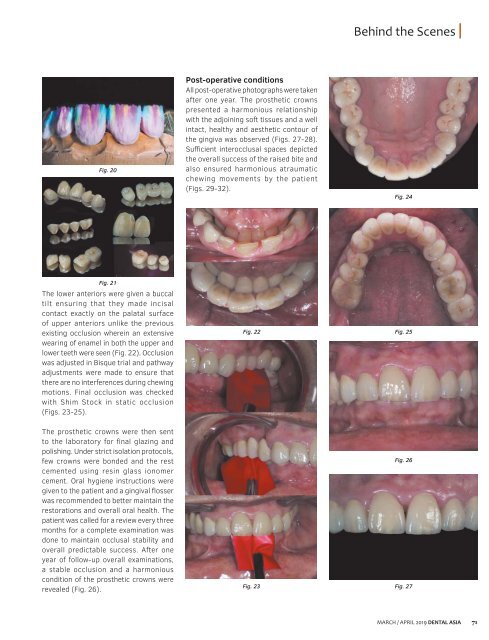Dental Asia March/April 2019
For more than two decades, Dental Asia is the premium journal in linking dental innovators and manufacturers to its rightful audience. We devote ourselves in showcasing the latest dental technology and share evidence-based clinical philosophies to serve as an educational platform to dental professionals. Our combined portfolio of print and digital media also allows us to reach a wider market and secure our position as the leading dental media in the Asia Pacific region while facilitating global interactions among our readers.
For more than two decades, Dental Asia is the premium journal in linking dental innovators
and manufacturers to its rightful audience. We devote ourselves in showcasing the latest dental technology and share evidence-based clinical philosophies to serve as an educational platform to dental professionals. Our combined portfolio of print and digital media also allows us to reach a wider market and secure our position as the leading dental media in the Asia Pacific region while facilitating global interactions among our readers.
You also want an ePaper? Increase the reach of your titles
YUMPU automatically turns print PDFs into web optimized ePapers that Google loves.
Behind the Scenes<br />
Fig. 20<br />
Post-operative conditions<br />
All post-operative photographs were taken<br />
after one year. The prosthetic crowns<br />
presented a harmonious relationship<br />
with the adjoining soft tissues and a well<br />
intact, healthy and aesthetic contour of<br />
the gingiva was observed (Figs. 27-28).<br />
Sufficient interocclusal spaces depicted<br />
the overall success of the raised bite and<br />
also ensured harmonious atraumatic<br />
chewing movements by the patient<br />
(Figs. 29-32).<br />
Fig. 24<br />
Fig. 21<br />
The lower anteriors were given a buccal<br />
tilt ensuring that they made incisal<br />
contact exactly on the palatal surface<br />
of upper anteriors unlike the previous<br />
existing occlusion wherein an extensive<br />
wearing of enamel in both the upper and<br />
lower teeth were seen (Fig. 22). Occlusion<br />
was adjusted in Bisque trial and pathway<br />
adjustments were made to ensure that<br />
there are no interferences during chewing<br />
motions. Final occlusion was checked<br />
with Shim Stock in static occlusion<br />
(Figs. 23-25).<br />
The prosthetic crowns were then sent<br />
to the laboratory for final glazing and<br />
polishing. Under strict isolation protocols,<br />
few crowns were bonded and the rest<br />
cemented using resin glass ionomer<br />
cement. Oral hygiene instructions were<br />
given to the patient and a gingival flosser<br />
was recommended to better maintain the<br />
restorations and overall oral health. The<br />
patient was called for a review every three<br />
months for a complete examination was<br />
done to maintain occlusal stability and<br />
overall predictable success. After one<br />
year of follow-up overall examinations,<br />
a stable occlusion and a harmonious<br />
condition of the prosthetic crowns were<br />
revealed (Fig. 26).<br />
Fig. 22<br />
Fig. 23<br />
Fig. 25<br />
Fig. 26<br />
Fig. 27<br />
MARCH / APRIL <strong>2019</strong> DENTAL ASIA 71


















